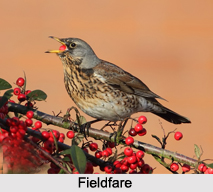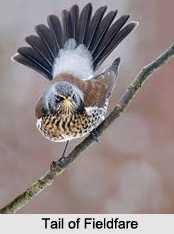 Fieldfare is an Indian Bird that bears a scientific name of "Turdus pilaris" and is a member of the thrush family Turdidae.
Fieldfare is an Indian Bird that bears a scientific name of "Turdus pilaris" and is a member of the thrush family Turdidae.
Breeding of Fieldfare
Fieldfare breeds in woodland and scrub in northern Europe and Asia. It is strongly migratory, with many northern birds moving south during the winter. It is a very rare breeder in the British Isles, but winters in large numbers in the United Kingdom, Southern Europe, North Africa and the Middle East.
Feeding of Fieldfare
Fieldfare is omnivorous, eating a wide range of molluscs, insects and earthworms in the summer, and berries, grain and seeds in the winter.
Nests of Fieldfare
Fieldfares often nest in small colonies, possibly for protection from predators. The nest is built in a tree where five or six eggs are laid. The chicks are fed by both parents and leave the nest after a fortnight. There may be two broods in southern parts of the range but only one further north. Migrating birds and wintering birds often form large flocks, often in the company of Redwings.
Structure of Fieldfare
Fieldfare is 25 cm (10 in) long, with a grey crown, neck and rump, a plain brown back, dark wings and tail and white under wings. The breast and flanks are heavily spotted. The breast has a reddish wash and the rest of the under parts are white.
Sexes of Fieldfare
The sexes of Fieldfare are similar in appearance but the females are slightly browner. The male has a simple chattering song and the birds have various guttural flight and alarm calls.
Description of Fieldfare
Fieldfare was described by Linnaeus in his Systema naturae (1758) under its current scientific name. The name Turdus pilaris comes from two separate Latin words for thrush. No subspecies are recognised.
 Colour of Fieldfare
Colour of Fieldfare
Fieldfare is easily recognisable with its slate-grey head, nape and rump, dark brown back, blackish tail and boldly speckled breast. In flight, its white under wing-coverts and axillaries are conspicuous. The harsh flight call "tsak tsak" is also distinctive.
Body of Fieldfare
The forehead and crown of Fieldfare are bluish-grey and each feather has a central brownish-black band. The lores and under-eye regions are black and there are faint, pale streaks above the eyes. The ear coverts, nape, hind neck and rump are bluish-grey, usually with a white streak near the shaft of each rump feather. The scapulars and mantle feathers are dark chestnut-brown with dark central streaks and pale tips. There are fourteen tail feathers each with a pointed tip, the outer two slightly shorter than the others giving a rounded tail. They are brownish-black, with inconspicuous darker bars visible in some lights. The outer edge of each tail feather is fringed with grey near the base and the outer pair of feathers has a narrow white border on the inner edge. The chin, throat and upper breast are creamy-buff with bold streaks and speckles of brownish-black. The lower breast is creamy-white with a diminishing buff tinge and fewer speckles and the belly is similarly creamy-white, with the speckles restricted to the uppermost parts. The primaries are brownish-black with the leading edge fringed grey and the inner edge of the outer feathers grey near the base whereas the inner feathers are fringed with brown near the base. The secondaries are similar but fringed with chestnut-brown on the leading edge. The upper wing-coverts are brownish-black and similar to the outer primaries in their margin colouration. The axillaries and under wing-coverts are white and the under tail-coverts have dark greyish-brown bases and margins and white centres and tips. The beak is strong, with a slight curve and a notch near the tip. It is orange-yellow in winter, with the upper mandible somewhat brownish and both mandible tips are brownish-black. In the summer both mandibles of the male`s beak are yellow. The irises are dark brown and the legs and feet are brown. The average adult length is 25 cm (9.8 in), the wing length is 14.5 cm (5.7 in) and the tarsal length is 3.5 cm (1.4 in).
Call of Fieldfare
The call of Fieldfare is mostly uttered in flight and is a harsh "tsak tsak tsuk". The same sound, but softer, is made more conversationally when individuals gather in trees. When angry or alarmed they emit various warning sounds reminiscent of the mistle thrush (Turdus viscivorous).
Migration of Fieldfare
The migration of Fieldfare southwards from the breeding range starts in October but the bulk of birds arrives in the United Kingdom in November. Some of these are still on passage and carry on into continental Europe but others remain. The passage-migrants return in April and they and the resident migrants depart from the United Kingdom mostly by early May.



















